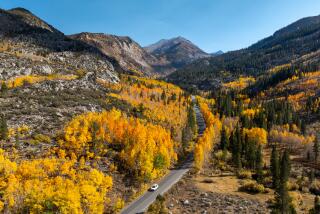Bird-watchers find their paradise
- Share via
WOFFORD HEIGHTS, Calif. -- John Schmitt is on peregrine patrol along the northern shore of Lake Isabella, but instead he spots a bald eagle perched on a tall snag in the shallows.
Fresh juvenile, the guide announces, while peering through his scope. Not long out of the nest, still dark brown, perhaps four years from attaining the telltale white head and tail feathers.
It’s early December, and Schmitt makes note because it’s his first bald eagle sighting this season. Last season, strangely, he saw none.
And so the morning tour of the vast Kern River Valley -- like the winter bird-watching season -- begins with promise.
Mountain bluebirds scamper as one over the barren shoreline.
White pelicans lounge on a distant sandbar. Mallards paddle leisurely across the lake’s glassy surface.
Ravens repeatedly rush the eagle in an unsuccessful attempt to spook it from the snag.
A pretty picture, sure. But Schmitt has more of his wondrous universe to unveil, so he motions for his guest to climb into the truck and off we go. . . .
--
The diverse Kern River Valley is a paradise for bird enthusiasts.
At one end is the Southern Sierra Nevada. Opposite is the Mojave Desert. Between are chaparral, oaks, grasslands, shrubs, woodlands, marshes and meadows.
Flowing through the valley is the south fork of the Kern River, sustaining the largest remaining riparian forest in California.
Nearly 350 species of birds have been identified locally. About 200 species breed here.
“If conditions are right you can have huge pushes of birds of many species, in very large numbers,” Schmitt says. “You’ll be turning every which way to try to see it all.”
Schmitt, 59, has been fascinated by birds since he was a child.
He kept them as pets and studied their behaviors and intricate feather structures.
He worked on the California Condor Recovery Program and spent weeks at a time alone in the backcountry.
He’s also a taxidermist, but these days, as a talented artist working from his hilltop home in Wofford Heights, he specializes in bird illustrations, which have appeared internationally in field guides, journals and magazines.
I became acquainted with Schmitt through Bob Barnes, a renowned local naturalist who was traveling during my visit and recommended I tour the region with Schmitt.
Both possess intimate knowledge of the region, and both occasionally lead tours. Barnes can be contacted via valleywild.org. Schmitt can be reached directly at (760) 376-6920.
--
“Humans just blunder through the landscape,” Schmitt maintains, as I trip over a fallen branch and prove his point. “These animals sense us long before we sense them, and they take the necessary measures to avoid us.”
We’re at Tillie Creek Campground, which is deserted save for its flora and fauna. Schmitt trains his scope on an adult male American kestrel perched atop a willow sapling.
“To me this is found art,” he says, noting the blue-gray wings and prominent black spots. “It’s such a handsome bird.”
Scrub jays and purple finches abound, and white-crowned sparrows, which signal the arrival of fall, are everywhere.
On a distant treetop, a red-tailed hawk puffs its breast feathers as a warning to other raptors that this territory is occupied.
Curiously, we see no rabbits or squirrels. Schmitt blames a prolonged drought and predicts this will be a difficult season for some raptors.
Moments later we discover a very thin long-eared owl, freshly dead, lying face-up in a macabre position on the pathway.
It’s almost as if it has fallen from the sky merely to underscore the severity of drought.
But in the shade of oaks we discover positive signs. Fresh white droppings and clumps of dove and quail feathers reveal positions of feeding avian predators.
Schmitt inspects the skull casing of a gopher regurgitated by a raptor; perhaps a peregrine, a Merlin or Cooper’s hawk.
Oddly, it’s still and quiet in the shade of the grove, while in the sunlight the branches and shrubs are aflutter, and birdsong fills the crisp morning air.
Nearby, a colorful acorn woodpecker alights atop a branch. Schmitt scopes it briefly, then calls for a change of habitat.
--
Weldon is an agricultural community across the lake. Its alfalfa fields generally teem with blackbirds, which Schmitt refers to as “falcon fodder.”
But on this early afternoon, peculiarly, there are no blackbirds and, thus, very little chance of a falcon attack.
There is, however, a northern harrier shadowing a mangy coyote ranging across a green meadow, counting on the canine to flush an easy meal.
But it’s not to be, so the harrier veers off and away.
To the west, in the high desert, the bird artist becomes more of a pie-eyed piper, wandering with a cassette player blaring birdsong in an attempt to lure cactus wrens.
Yet all that appears is a lone rock wren, out of place, further perplexing the guide.
Schmitt will not get his cactus wrens, nor his peregrine. But his tour ends on a high note nonetheless, with the sighting of a beautiful Ferruginous hawk atop a highway-side power pole.
Its snowy white underside beams like a beacon, and it watches warily as we climb slowly from the truck.
Amazingly, as we take turns looking through the scope, it seems as if this magnificent raptor, with such powerful vision, can see into our eyes through the glass.
“To me this is just a beautiful hawk,” Schmitt says, as the bird spreads its wings and soars gracefully to another pole.
“Found art,” I mutter in response.
--
More to Read
Sign up for The Wild
We’ll help you find the best places to hike, bike and run, as well as the perfect silent spots for meditation and yoga.
You may occasionally receive promotional content from the Los Angeles Times.






